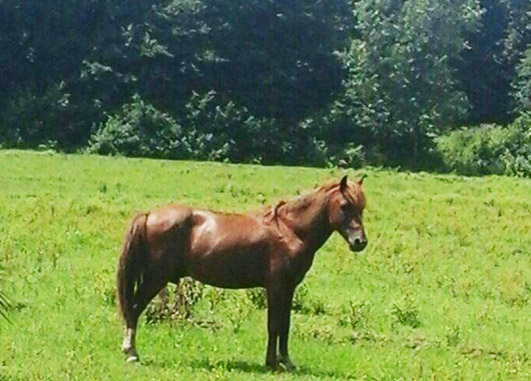A new D blood group phenogroup consisting of the specificities adeo was observed in a stallion family of Caspian ponies from Iran. An additional six undescribed genetic variants were seen in a total of 82 Iranian horses.
This result suggests extensive new genetic variation may be present in domestic horses from geographic regions that have not yet received scientific attention.
Keywords: alloantigens, blood typing, equine, erythrocyte, genetics, horse
E. Gus Cothran & Y. G. Long
Department of Veterinary Science, University of Kentucky, Lexington, Kentucky, USA.
Correspondence: Dr. E. Gus Cothran,
Department of Veterinary Science, 102 Animal Pathology Bldg., University of Kentucky, Lexington, Kentucky, 40546-0076, USA.
The 0 blood group is among the most variable genetic systems of the horse. There are currently 17 internationally recognized specificities and 25 phenogroups (Bowling and Williams I 1991) assigned to the 0 red cell alloantigen system. Since the current nomenclature was established, most new variants have resulted from the discovery of new specificities that have split known phenogroups (e.g. Bowling, 1987) rather than new combinations of factors (e.g. Aguilar et aI., 1987). Here we report a new combination of factors in a phenogroup found in the Caspian pony from Iran.
A total of 41 Caspian ponies from Iran were tested using hemagglutinating , alloimmune reagents. The 0 system reagents tested were a, b, c, d, e, f, g, h, k, m, n and o. Included within this sample was a stallion with an unusual combination of 0 system factors that did not conform to any described phenogroup. Seven offspring of this stallion also were typed along with the dams for six of the offspring. Absorption
tests were run to confirm the types of all these individuals. The results are shown in Table 1. The stallion appears to have the phenogroups Ddfk/Dadeo. The new phenogroup Dadeo was passed on to five of the seven offspring of the stallion. We presume this phenogroup is actually Dadelo although we were unable to test for the 01 factor. Also, we were unable to test for Dq and Dr which frequently occur with the
Dadl or Ddelo phenogroups (Bowling and Williams, 1991).
A total of eight 0 system phenogroups were found in this population of Caspian ponies. Included in this number was one individual that appeared to have the unusual phenogroup Ddlno (1 presumed) previously reported py Bowling and Williams (1991 ).
No family data was available for this horse. The other variants present were Dbcm, Dcgm, Ddeo, Ddfk, Ddghm, and Ddk. An additional 53 Caspian ponies from England have been tested. With one possible exception this group did not have the Dadeo phenogroup. The exception was an individual that was positive for the factors Da, Dd, De and Do. However, this individual could have been Dad/Ddeo. The 0 system variants present in the English Caspians were Dad, Dbcm, Dcgm, Ddeo, Ddfk, Ddghm, and Ddk. The English population was derived from 20 ponies brought to England from Iran in the 1970s.
A newphenogroup in the horse 0 system ofred cell alloantigens found in the Caspian Pony 3 The observation of a new phenogroup within the equine 0 blood group system is not remarkable. However, this new 0 system variant was not the only new marker found in Iranian horses. We have tested 82 horses from Iran that are of breeds that are rare or unknown in the west. In addition to the Dadeo and Ddno, we observed six variants that, to our knowledge, represent new genetic variants for the horse. Two were in the A-l-B (alpha-l-beta glycoprotein) system, one was in Tf (transferrin) and three were in the Pi (protease inhibitor) system. Unfortunately, there was little or no family data to demonstrate Mendelian inheritance of these variants. The number of Asian and African horse breeds that have not been examined genetically means that there is likely to be considerably more genetic diversity in domestic horses than is now recognized.
Acknowledgements
We sincerely thank Louise Firouz, and Dr. Farshad Malouf! of Teheran, and Dr. Iradj Nowrouzian of the Faculty of Veterinary Medicine, Teheran Univ., for providing the samples. We also acknowledge the efforts of the technical staff of the Equine Blood Typing Research Laboratory at the University of Kentucky. Dr. K.A Graves provided a critical reading of the manuscript, The investigation reported in this paper (No. 93-4-107) is in connection with a project of the Kentucky Agricultural
Experiment Station and is published with approval of the Director.
References
Aguilar P., De Andres Cara D.F. & MeriauxJ.C. (1987) The Spanish Pure-Bred horse: a new combination of factors in the 0 blood group system. Animal Genetics 18 (Suppl. 1), 1 26-7.
Bowling A (1 987) Three new factors which split the blood group Dcgm of the horse. Animal Genetics 18 (Suppl. 1), 127-8.
Bowling AT. & Williams MJ. (1991) Expansion of the 0 system of horse red cell
alloantigens. Animal Genetics 22, 361-376.

